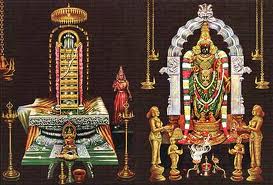Sri Kalahasti Temple:
SriKalahasti temple is located 36 km away from Tirupathi in Chittoor district of Andhra Pradhesh, India. The inner temple is constructed around 5th century and the outer temple was constructed in the 12th Century.
The following text which has some real good stuff about "Symbols of the Self" is obtained from the website
According to ancient Tamil sources Sri Kalahasti has been known as the ‘Kailas of the South’ for slightly more than two thousand years and the small river on whose banks it sits, the ‘Ganges of the South.’ Kailas is perhaps India’s most revered spiritual symbol. It is the abode of Shiva, from whose head, according to legend, the Ganges is said to flow. Shiva, ‘that which is auspicious at all places, times and in all circumstances’ is a symbol of the Self and the Ganges flowing from his head represents the spiritualized or awakened mind. A mind sourced in Spirit is a river of immeasurable power and life-giving goodness. The claim that Kalahasti is the ‘Kailas of the South’ simply means that the small hill near the temple is to be taken as the spiritual equivalent of the Himalayan Kailas. Likewise, the small river flowing in a northerly direction beside the temple is to be taken as the mighty Ganges.
Even the cardinal directions have assumed symbolic significance in Pauranic culture. Obviously context should be taken into account when divining the meaning of a symbol, but north, for example, is said to be the abode of the Self because from the immortal ‘northern’ position the Self looks out on the ‘southern’ world of time and death. The idiom to “head south’ means to go downhill, to decay. The God Dakshinamurthy whose name means ‘the one facing south’ and whose idol (murthy) is installed in the Kalahasti Temple, sits in the North and faces south. East often represents the dawning of wisdom, the sun being another common Self symbol. The symbolic use of direction culminates in the idea of building temples at the point on a river where its meandering points it back to its source. The holiest city in India, Benaras, is built on a stretch of the Ganges that flows northward, the idea being that when the mind turns back toward its source, the God/Self, it realizes its innate divinity. So, the small river on whose banks the Kalahasthi temple is situated is meant to remind us of the Ganges and the wealth of spiritual associations it conjures.
The Vedas posit four ends for which human beings strive in their search for happiness: pleasure (kama), security or wealth (artha), duty (dharma) and freedom (moksha). In the temple at Kalahasti these four universal motivations, which may take any worldly form, are, according to temple literature, converted into spiritual impulses. They are represented by four deities facing in the four cardinal directions. Shiva in the form of Dakshinamoorthy represents desire, in this case the desire for liberation, although he more commonly is said to represent the feeling of wealth (dakshina) that comes when you know who you really are. At Kalahasti the Goddess Gnanaprasoonamba (the giver of knowledge or the mother of all knowledge) represents the ‘wealth’ i.e. freedom from limitation conferred by Self knowledge. The deity Kalahastishwara (the lord of Kalahasti) faces west and symbolizes liberation. Liberation, the death of ego upon the rediscovery of the Self, is the final stage of life just as setting is the sun’s last act before it disappears over the horizon. Unfortunately the temple literature from which this information was gleaned neglected to include mention of the forth deity.
The most revered and universal symbol of the Self is the human form, ‘man cast in the image of God’ and its spiritual significance is difficult to overestimate. Rather than conceive of us as tainted sinful human creatures, the Upanishad tells us that we are divine. It says, “That which you worship there is this that you see here.” The ineffable formless God/Self perceived by mystics is this whole world and everything in it. While Hindu deities often sport dozens of arms and animal heads their essential forms are recognizably human. Probably no other idea accounts for the astonishing fact that one billion people stuffed into a land mass one third the size of the United States undoubtedly handle their lives more confidently than their prosperous Western counterparts.
